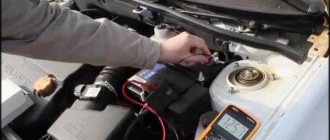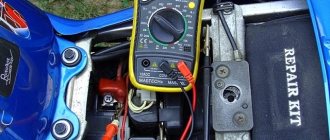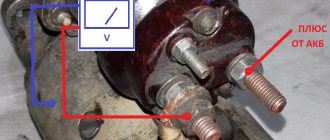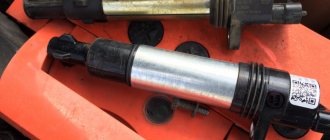Gasoline generators, even if they are made in China, are very reliable with proper care . However, during their operation, small problems may arise that can usually be quickly fixed with your own hands. Serious breakdowns, provided the owner knows the device and the operating principle of the generator, will also not be able to disable it for a long time.
How to remove oil
The main methods used to eliminate the problem:
More often, oil enters the filter along with the gases that pass through it. To solve this problem, you will need to remove the hose from the filter, rinse it from impurities and debris that have clogged the element, and then install the hose back. If this does not help, you will have to check the throttle valve. Carbon deposits and debris often prevent the part from working properly, causing high pressure in the engine. More often the problem is solved by repairing the damper or replacing it.
Slag can accumulate in the vehicle's oil slinger; To fix the problem, you will need to clean this element and install an additional oil deflector.
If the air filter is damaged or clogged, it may itself be the cause of oil. In this case, the filter can be replaced or cleaned.
If the problem has not been solved, then the cause will have to be looked for in the engine. This means that the car will require more serious repairs: replacing oil rings or other types of manipulation.
Oil in the air filter pipes often appears due to poor compression in the car’s cylinders. You can check how the cylinders work by warming up the engine to operating temperature. If the values are not the same, then the engine requires repair. This problem occurs especially often in older cars.
The owner will also need to check the valve clearances. If they are too large, oil will begin to appear in the air filter. The same applies to replacing oil seals. In a garage environment, it is difficult to determine the cause of a vehicle malfunction. Most owners turn to a car service center, where diagnostics are carried out by technicians using special equipment.
If your car's engine is worn out, you can delay major repairs by doing the following:
- The hose conducting gases through the crankcase must be removed.
- A plug is installed on the fitting.
- The crankcase is ventilated through an extended length hose, which is passed through the bottom of the engine.
- Replace engine lubricant.
But these manipulations will delay the intervention of repairmen by a maximum of 500 km. After this, the motor will need to be repaired or a new unit installed.
What is the problem?
The presence of oil on the air filter itself will not cause harm, but it can serve as an alarming symptom that the need for a major engine overhaul is approaching, and this procedure is labor-intensive and expensive. The appearance of a sign requires prompt contact to a car service for in-depth diagnostics of the car.
Key Features
When checking engine compression, you must remember that a discrepancy of one or two units is acceptable. If the compression in the cylinders is very different from each other, then this indicates that the valves are burnt out or the rings are not pressed tightly, and it’s time to change them.
It is worth paying attention to what color the car's exhaust gases are. If the piston group is heavily worn, the smoke will take on a bluish tint.
If, after checking the compression in the cylinders, no serious deviations from the norm could be detected, then there is no cause for concern, and the oil most likely comes through the crankcase due to a hose clogged with debris. The hoses are easy to clean or replace.
Performance Diagnostics
There are several ways to test a generator. The surest way is to carry out diagnostics using a multimeter. This device is sold in almost every auto store.
The simplest check algorithm that you can do yourself looks like this:
- Start the car.
- Make sure that all external and internal electrical equipment is turned off.
- Select the DC voltmeter scale on the device.
- Connect to the battery terminals and take readings on a multimeter.
The voltage should be around 14 volts. Then you should add the electrical load one by one: headlights, seat heater, audio system. If at any time when new consumers are connected the voltage drops below 12 volts, then there is a problem in the vehicle’s on-board network. Next, you should make sure that the same voltage is present at the terminals of the electric generator
If this is not the case, you need to look at the battery, not the alternator.
There is a dangerous way to check if your car's alternator needs repair. This method is practiced by owners of old car brands. It involves disconnecting one of the battery terminals while the engine is running. If the car stalls instantly or within 30 seconds, then most likely the alternator is unusable.
Types of generator faults
Due to the fact that any generator is an electromechanical device, there will be two types of faults - mechanical and electrical.
The first includes the destruction of fasteners, housing, malfunction of bearings, pressure springs, belt drive and other failures not related to the electrical part.
Electrical faults include winding breaks, diode bridge faults, brush burnout/wear, turn-to-turn short circuits, breakdowns, rotor beating, and relay-regulator faults.
Often, symptoms that indicate characteristics of a faulty generator can also appear as a result of completely different problems. As an example, poor contact in the fuse socket of the generator field winding circuit will indicate a generator malfunction. The same suspicion may arise due to burnt contacts in the ignition switch housing. Also, the constant lighting of the generator malfunction indicator lamp can be caused by a breakdown of the relay; the blinking of this switching lamp may indicate a generator malfunction.
The main signs of a malfunctioning autogenerator:
- When the engine is running, the battery discharge warning lamp flashes (or stays on continuously).
- Discharging or overcharging (boiling) of the battery.
- Dim car headlights, a rattling or quiet beep when the engine is running.
- Significant change in headlight brightness with increasing speed. This may be acceptable when increasing the speed (re-throttle) from idle, but the headlights, having lit up brightly, should not increase their brightness any further, remaining at the same intensity.
- Extraneous sounds (howling, squeaking) coming from the generator.
It is necessary to regularly monitor the tension and general condition of the drive belt. In case of cracks and delaminations, immediate replacement is necessary.
What breaks
A car generator lasts a long time. Usually, owners of used cars have problems with it due to the time factor. There are few parts in this device, as you can see in the image below.
Statistics of faults associated with car generators allow us to compile a list of parts with the most frequent breakdowns:
| 1. | Brushes |
| 2. | Bearings |
| 3. | Diodes |
| 4. | Voltage regulator |
The car is equipped with an on-board network status alarm. But it is triggered when there are obvious problems with the voltage at the battery terminals. And this is due to diodes, voltage regulator and insulation on the wires. The condition of bearings and brushes can only be determined by external signs and upon inspection.
But while bearing wear can be assessed by grasping the generator shaft and shaking it, you can only see the brushes by removing the voltage regulator. And to do this you will need to remove the generator from the car. You shouldn't do this just to inspect the brushes. But sooner or later one of the above malfunctions occurs. And then you will have to remove the generator for inspection and repair.
Details about the appointment
Equipment of this kind can perform different functions, each of which is extremely important:
- Providing autonomous backup power supply to the facility;
- Operating on a permanent basis if there are no power lines in the area.
Considering the magnitude of the load on such a compact device, it is quite logical that gas generators need to be repaired periodically. To ensure that this has to be done as rarely as possible, maintenance of the main components should be carried out on time. The increased load on such a device lies in the fact that several consumers can be powered from it simultaneously, and the duration of operation is often quite long.
Thus, even despite the need to repair gas generators from time to time, a device of this type is sometimes necessary to have in everyday life. Among other things, there is another factor that speaks in its favor - the organization of a stable output voltage for connecting equipment with sensitive automation.
Design and basics of operation
A gasoline generator is a device that runs on liquid fuel. Its task is to convert the mechanical energy of the engine into electrical energy, which is produced by the alternator. These are two main nodes that are interdependent. Repair of gasoline generators is most often associated with the maintenance or replacement of elements that are part of the engine and alternator or are functionally connected to them.
The engine is equipped with a number of systems: starting, shaft speed stabilization, cooling, exhaust and air supply. This unit is driven most often in two ways:
- By hand pull;
- Electric starter.
In more functional models, the engine is started by autostart. If it is quite possible to repair autonomous gas generators of a mechanical starting system yourself, then understanding the automation is much more difficult.
There are single-phase and three-phase devices. If the former are not as functional as the latter, they are less powerful. However, the advantage of three-phase models is the ability to connect a single-phase network if necessary.
There are single-stroke and four-stroke models of alternators (generators). In gasoline mechanisms, the second of these are most often used.
How to start in winter?
Surely everyone will agree that it is very unpleasant to find yourself in a house without electricity in winter in cold weather. And if you have a properly connected gasoline generator, such problems do not arise. However, owners of such devices need to remember that there are several ways to start gasoline power plants in winter.
- Regardless of the method of connecting the device, you must treat the injectors with care. They should be held at a certain angle to prevent fuel fluid from getting onto the spark plugs.
- You can inject a special agent into the carburetor to quickly start a gasoline generator. You can purchase this substance at any electrical goods store.
- The easiest way to start a gasoline generator requires taking the device into a warm room, warming it up, and then returning it to its place. Most likely, the unit has been frozen and, like a car battery, requires heating the electrolyte. This method cannot be called fast, but it is “miraculous.”
To protect the generator system from various damages during cold weather, the owner must drain the fuel liquid from the tank and lubricate the movable components of the system, especially when the next start will be made after a long time. But the most important thing is that a poorly functioning generator must be kept in rooms where the air temperature does not fall below 0 degrees.
Problems with the internal combustion engine.
The reasons for this may be the following:
- Lack of elements necessary for engine operation - fuel, oil, uncontaminated air filter. The presence of these components is the key to good operation of the gas generator; in their absence, the protective mechanism is triggered and the device stalls.
- There is no ignition spark. You can fix the problem as follows: using a special wrench, unscrew the spark plug, then, using sandpaper and an iron brush, clean off the resulting carbon deposits that appear when using low-quality fuel due to its incomplete combustion. Then you need to wipe the candle with gasoline or alcohol and let it dry. After this, you should check again for the presence of an ignition spark and try to start the generator.
- Insufficiently adjusted carburetor, soot appears when the generator is not operating at full capacity. Additional adjustment of the carburetor will help solve the problem.
- Other serious generator failures.
Problems in the operation of an electric generator usually arise due to a lack of voltage, which occurs due to a number of reasons. This may be a lack of contact, faulty brushes, burnout of capacitors, PWM units, etc. If voltage surges are observed at constant engine speeds, then most likely the issue is a malfunction of the excitation regulators. It is necessary to disassemble the device to find out the exact reason for its failure to work.
Difficulty starting the engine usually indicates a malfunction. Finding the cause in a timely manner means preventing its further development and stopping the negative impact on the operation of the unit.
Often the cause of a malfunction is several interrelated factors. In this case, they have to be eliminated comprehensively.
Most often, the circumstances that prevent normal engine starting are:
Poorly functioning ignition system. The following options are possible here:
Problems with the spark plug: too large or too small a distance between the electrodes (the electrodes must be positioned at the optimal distance), insulation failure (replacing the spark plug with a new one will help), formation of heavy carbon deposits (the spark plug must be thoroughly cleaned);
Problems with the ignition coil: insulation failure or winding rupture (replacement required), incorrect connection of circuit elements or interruptions in its operation (if it is impossible to eliminate the fault of the microcircuit, its replacement is necessary).
Poorly functioning fuel system
Causes and solutions:
- Lack of fuel in the tank (the tank needs to be refilled);
- Clogged or pinched fuel hose (thorough cleaning or complete replacement of the hose is required);
- Air trapped in the fuel hose (check the tightness of the connections, tighten if necessary);
- Low quality gasoline or diluted with water (fill with higher quality fuel);
- Problems with the carburetor: breakdown, fuel or debris getting into it. Disassembling and cleaning the carburetor will solve the problem. Also, the reason may be an incorrectly installed throttle valve, which can be solved by carefully adjusting this part.
Problems in the main engine components
Causes and solutions:
- Poorly tightened cylinder head bolts (tighten more tightly)
- The piston, piston rings or cylinder are worn out (needs repair or complete replacement)
- Poor contact between the working chamfers and the seats (repair required)
- Sticking valve (needs repair)
- The gap between the valves, the value of which differs from the gap size provided for this model (careful adjustment of the gap value is required);
- The intake manifold gasket does not prevent the passage of air (tighten the bolts; if air continues to pass through, the gasket needs to be replaced)
- Poorly tightened spark plug (tighten the spark plug more)
Does it make sense to use it?
As stated above, the purpose of the hydrogen installation is to save the amount of fuel used, and it does not matter in what mode the car is used - in the city or on the highway. The amount of fuel saved directly depends on the power of the installation, as well as the model of the vehicle and the operating features of its power unit
Today, such a device is not so often used by motorists. But those drivers who have installed a hydrogen unit on their car note that during normal engine operation, fuel savings can amount to around 15-30%. However, every car enthusiast should understand that the use of such devices not only contributes to fuel economy, but also affects the functionality of the car as a whole, and not always on the positive side (the author of the video is the Meso channel).
When should you contact the workshop?
A number of malfunctions, alas, are quite difficult to fix with your own hands without sufficient qualifications: for example, a faulty inverter converter or voltage regulator can be repaired only with a good understanding of the operating principle and circuitry of such devices. Not every owner of a gas generator will undertake to overhaul the engine, although this is not as difficult as it might seem.
In this case, you should contact a specialized repair shop. You can find out the coordinates of workshops in your city on the Internet or in stores selling gas-powered tools.
There are many such workshops in large cities , here are just a small part of them:
| City | Workshop | Coordinates |
| Moscow | "Electrical petroleum engineering" | 13 centers in Moscow and 18 in Moscow Region |
| "Southeast" | Maryino, Stavropolsky proezd. possession 199 (499) 390-93-49 | |
| Saint Petersburg | "Lenremont" | 7 workshops |
| "Benzomix" | st. Uchitelskaya, 23, ATOLL business center, office 154 (812) 385-54-30 | |
| Nizhny Novgorod | "Machines" | st. Rodionova, 24 (831) 412-92-48 |
| Novosibirsk | "RemCity" | st. Topolevaya, 3 |
| Vladivostok | "Gasoline unit" | st. Dorovolsky (4232) 273-273-9 |
The video shows the repair of a Chinese-made gas generator
Troubleshooting basic gas generator problems on your own.
The basic principle of repairing any equipment is eliminating faults by elimination. How we do it. The generator comes to us and we begin to check:
- First of all, we inspect the appearance for mechanical damage and oil leaks, as well as the presence of rust in the tank. Next, check the presence of oil and crank the engine with the starter (check the compression resistance and extraneous noise). Let's try to start it.
- If not, look for a spark. We immediately take a new spark plug (leaning the spark plug against ground and cranking the engine), if there is no spark or it is weak, we try to disconnect the wires from the oil sensor relay and replace the spark plug cap. If it doesn't help, look at the ignition switch or power button. If everything is fine there, then the ignition coil is faulty.
- If there is a spark, we try to start it. If it starts and stalls or runs with the choke closed, the carburetor is definitely clogged. Many people say that they cleaned it themselves, but the symptoms are the same. This is obvious; you need to clean the carburetor by disassembling it down to the bolt using special means. And that’s half the battle, then you need to install it and correctly adjust the rods and springs of the damper and speed controller. If it does not start at all, add a little gasoline to the combustion chamber, through the spark plug hole or an open carburetor choke.
- Rust in the tank is a very annoying problem, you can clean the fuel system and everything will work. But soon, after some time, this rust will get into the carburetor (into the jets, under the needle) and the symptoms will repeat. If there is rust in the tank, it is almost impossible to remove it. You can pour special agents (such as solvent) into the tank overnight or install a fuel filter, but the only salvation is to replace the tank.
Many people have a need to provide their home with an uninterrupted power supply system - the quality of domestic electricity supply is low, which is especially typical for suburban and rural areas. The most common solution is to purchase a gas generator - these devices are available in a wide range and have an affordable price. However, a gas generator, being a rather complex device, has many features, the knowledge of which is necessary for every owner to properly use such equipment.
Engine breakdowns
- The equipment stalls immediately after starting or does not start at all. There may be several reasons: lack of spark, poor fuel supply, gas distribution mechanism, mechanical failures (connecting rod failures, crankcase breakdowns, etc.).
- Spark. The problem may be a burnt-out coil, spark plug, or cap. The relay or the oil sensor itself may fail (it stops sparking if there is little oil), as well as the electrical wiring.
- Poor fuel supply. One or more elements of the fuel system - gas tank, filter, tap, carburetor - is clogged or faulty.
- Timing belt If gaps and scale on the metal increase and accumulate accordingly, the engine may not start.
- Smoke from the engine. Problems with pistons and/or cylinder. Oil enters the combustion chamber due to the exhaustion of the piston - hence the smoke. Too much oil in the fuel mixture also causes smoke.
- The motor started knocking. Abrasion of the crankshaft or other engine elements.
- Fuel in the crankcase. Gasoline and oil are leaking from the crankcase. Carburetor failure. The reasons are its obsolescence and/or accumulation of dirt.
- The motor jams. Engine obsolescence, lack of oil, excessive carbon deposits in the combustion chamber.
Preventive measures
The device should be cleaned from time to time. We are talking about cleaning the fuel tank, as well as the elements of the cooling system from carbon deposits and dust. This will keep the device clean, and blockages will not cause it to overheat and subsequently fail.
In addition, it would not be superfluous to disassemble it from time to time and check the functionality of various mechanisms.
You will need to check the ATS and the functionality of the control unit especially carefully. If possible, it would be a good idea to also clean the internal elements from dirt and dust. Considering the design features of this device, there are no large-scale preventive measures for it.
To this you can also add monitoring the fuel and oil levels, checking the strength of fastening of various elements with bolts, as well as periodically cleaning the air filter from dirt and dust.
Overload
Sometimes it happens that a power plant can be overloaded with consumers and devices, the sum of their powers exceeds the rated power of the generator. Try running the generator completely without load or simply disconnecting several devices from it.
Carburetor clogged
Check the gas generator carburetor for blockages.
Gasoline injection needle clogged.
If the needle is clogged, it must be cleaned. Blow it out using a car compressor. Apply the nozzle.
Video instructions for cleaning the carburetor needle
https://youtube.com/watch?v=2UZLvmf_mWM
Clogged or stuck float mechanism for supplying fuel to the gasoline unit.
Purchase a carburetor cleaner and treat the entire structure. Wait a few minutes, and then move the float mechanism with your own hands and blow out the valve.
https://youtube.com/watch?v=oVhJbqFMKgA
Valve repair
The valves of a gasoline engine are controlled by a timing belt. To check its operation, remove the unit cover by unscrewing several bolts. You will see several valves and a pushrod. You need to push the shaft in the right direction. If you see that everything is moving, but the valves are not moving, then they are stuck. To repair them, take a carburetor cleaner and a hammer.
Rotate the rocker arm and carefully hammer in the valves. Next, turning the shaft, push the valves back, pouring plenty of liquid on them
Repeat this step until the valves come off.
The generator works, but does not provide energy.
If the gas generator starts but does not produce energy, then most likely the engine is damaged or the internal settings of the generator are lost. Take a voltmeter and an ammeter and compare the readings at the power plant with the readings given in the instructions. If the readings differ, then this is certainly an internal failure and your unit needs professional examination and repair. So call the experts.
Emergency start of a power plant using a drill and battery
If your portable generator starts but does not produce power, you can:
- Use the battery after connecting the wires to it correctly (plus to plus, minus to minus).
Remove the spark plug and start the engine by pulling the starter cord.
Starting with a drill.
Use a drill to restore the alternator's magnetic field. This video will clearly show how to do it yourself.
Advice: the best way to prevent breakdowns of expensive equipment is to maintain it correctly and in a timely manner, even if your autonomous power source only works from time to time. Also promptly change filters and other elements that require periodic replacement. Remember that it is better to play it safe and replace the filter than to rely on chance.
Finally, remember to use good quality oil and fuel. You will save a lot of money and time if you are familiar with the basic troubleshooting methods and can repair a gasoline generator yourself. Most of these techniques are described in the instructions for use for your model. Do your research first before calling the experts.
Clean the exhaust system
There should be a valve or small hole on the back cover that acts as a crankcase gas valve. The vent allows gases to escape, providing efficient power to the system.
When a vent is clogged, the required airflow does not reach the environment. On the other hand, if the vent is slightly clogged, the system will work but will not perform well. Cleaning a vent is just as easy by making a small hole with a piece of wire or even blowing compressed air into it.
The gas generator works intermittently
A malfunction of the regulator is signaled by a situation when the revolutions of the gas generator fluctuate under load, and there are interruptions in starting a cold and hot engine. If measures are not taken, the situation will be aggravated by premature wear of internal components and failure of the device.
Adjusting the frequency of a gasoline generator can solve the problem, but it must be done correctly. The work will require a tester for measuring frequency and a long screwdriver with a Phillips head. Compliance with the given algorithm of actions will allow you to perform power plant maintenance quickly and safely:
- The first step is to disassemble the carburetor to gain access to the fuel jets. Then, using a compressor, carefully blow out the jets, channels and emulsion tube.
- The next task is to find the quantity screw and set the throttle valve so that the minimum gap value is 1.5 mm. Upon completion of the manipulation, the output parameters are checked. The value should not go beyond the range of 210-235 V. It is optimal to achieve a balance between the number of generated revolutions and voltage.
- Next, you need to work with the mixture quality screw to eliminate interruptions during idle. It is found in a special hole, screwed until it stops, and then loosened two or three turns. During the adjustment process, make sure that the device operates without problems during a cold engine start or at idle.
Violation of the given operating procedure will lead to a decrease in the effectiveness of the adjustment, and the master will not achieve his goal. If the algorithm is followed, there will be no further interruptions. A simple test will help ensure that the adjustment is correct. You need to put in a clean spark plug, turn on the gas generator for a couple of minutes and assess its condition. The presence of carbon deposits is a sign that adjustment needs to be continued by gradually loosening and tightening the bolts. If the spark plug is clean, the test is considered passed and the device is ready for further use.











